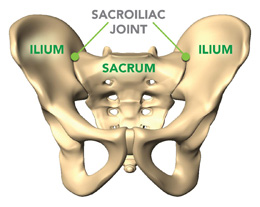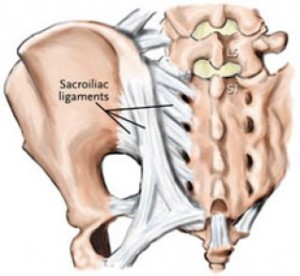The sacroiliac joints of the pelvis are two long grooves in either hip that frame the sacrum. The sacrum is an amazing section of our anatomy— part of both the pelvis and the spine. The sacroiliac joints are synovial joints which means they are encased in fluid meant to facilitate their movement and good walking patterns and posture are highly dependent on their alignment and mobility. Unfortunately a great deal of back, hip and associated pain stems from poorly aligned and immovable sacroiliac joints.
The pelvis is made up of three bones (two hips and the sacrum) that number anywhere from thirteen to fifteen at birth and solidify into the hips and sacrum at different stages of our youth. The sacroiliac joints are bound together by a series of strong ligaments that provide stability and control the amount of glide between the bones.
Ligaments connect bone to bone and are not mean to stretch but different people have different tone or laxity in their ligaments and those with a tendency towards looser ligaments are more prone to injury. Extremely loose people with ligament issues will speak of their sacrum going “out” repeatedly. And a great many back pain sufferers feel their pain directly in the sacroiliac joints. The opposite is occurring in people as well—dry, stuck sacroiliac joints that lack suppleness for a number of different possible reasons.
The ligaments of the pelvis are designed to loosen during pregnancy with the release of the hormone relaxin. Without the release of this hormone the pelvis, at the pubic bone and sacroiliac joints, would not be able to open enough to allow for childbirth.
The small amount of movement available within the sacroiliac joints is essential to the successful rotation that is required of the pelvis when walking. And the sacroiliac joints that have access to that glide function as shock absorbers in the same way that all segments of the spine bear and transfer weight.
The sacroiliac joints are particularly vulnerable to poor walking patterns that can keep these joints from moving freely.


